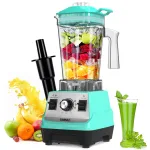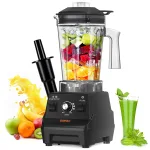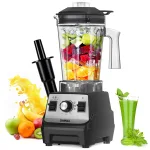In today’s fast-paced life, the blender, with its unique working principle and diverse functions, has become an indispensable member of the kitchen. This appliance, which integrates stirring, grinding, juicing, and more, not only simplifies cooking processes but also fully releases and utilizes the nutritional value of food.
I. The Working Principle of the Blender
The blender’s working principle relies heavily on its high-speed rotating blades and powerful motor. When the motor starts, the blades begin to rotate at an extremely high speed, generating strong centrifugal force. This force causes the ingredients inside the container to constantly collide and rub against each other, effectively breaking down their cell walls. The rupture of cell walls releases nutrients that were previously trapped within, such as vitamins, minerals, and dietary fiber. These nutrients then mix thoroughly with water or other liquids, creating smooth and creamy drinks or foods.
II. The Diverse Functions of the Blender
- Nutrient Extraction: As mentioned, the blender’s most notable function is its ability to extract nutrients from ingredients through its blending technology. This ensures that drinks or foods made with the blender are not only tastier but also more nutritious.
- Stirring and Grinding: The blender is also capable of powerful stirring and grinding. Whether it’s hard nuts, beans, or soft fruits and vegetables, the blender can easily pulverize them. This makes it effortless to create various sauces, pastes, and seasonings.
- Juicing and Smoothies: By adjusting the speed and adding ice cubes or cold water, the blender can produce refreshing fruit juices and smoothies. Its efficient juicing capabilities ensure that the nutritional content of the juice is preserved to the greatest extent.
- Cooking Assistance: In addition to the above functions, the blender can also assist in cooking. For example, when making soup or porridge, the blender’s stirring function can ensure that the ingredients are evenly mixed, enhancing the overall taste.
- Automatic Cleaning: Many modern blenders come equipped with an automatic cleaning function, significantly simplifying the cleaning process and allowing users to enjoy cooking with greater ease.
III. The Advantages of the Blender
- Efficiency and Convenience: With its high-speed rotating blades and powerful motor, the blender can quickly complete the crushing and mixing of ingredients, greatly improving cooking efficiency.
- Nutrient-Rich: By extracting nutrients from ingredients, the blender ensures that drinks or foods made with it are healthier and more nutritious.
- Versatility: The blender’s multiple functions cater to users’ diverse cooking needs.
- Easy to Clean: The automatic cleaning function or easy-to-disassemble design makes cleaning the blender simple and quick.
In conclusion, the blender, with its unique working principle and diverse functions, stands as a master of nutrient extraction in modern kitchens. It not only simplifies cooking but also ensures that the nutritional value of food is fully utilized. As technology advances and consumer demands diversify, the blender will continue to leverage its strengths, bringing healthier and more convenient lifestyles to people.













Add comment
You must be logged in to post a comment.